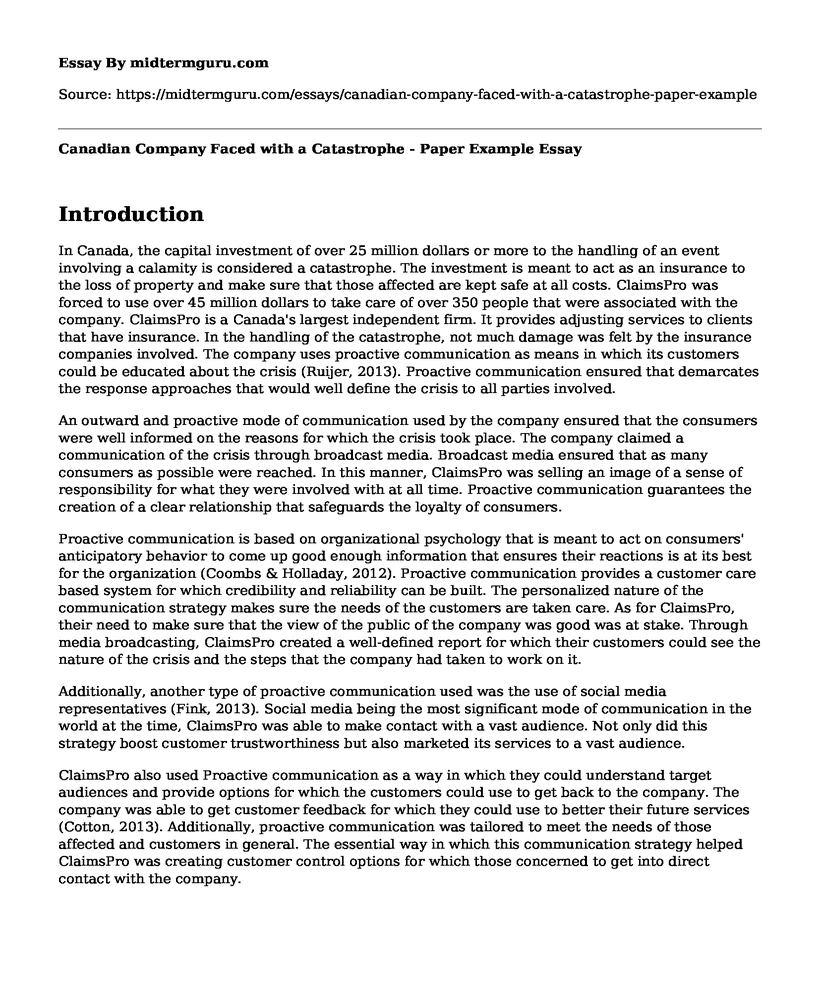Introduction
In Canada, the capital investment of over 25 million dollars or more to the handling of an event involving a calamity is considered a catastrophe. The investment is meant to act as an insurance to the loss of property and make sure that those affected are kept safe at all costs. ClaimsPro was forced to use over 45 million dollars to take care of over 350 people that were associated with the company. ClaimsPro is a Canada's largest independent firm. It provides adjusting services to clients that have insurance. In the handling of the catastrophe, not much damage was felt by the insurance companies involved. The company uses proactive communication as means in which its customers could be educated about the crisis (Ruijer, 2013). Proactive communication ensured that demarcates the response approaches that would well define the crisis to all parties involved.
An outward and proactive mode of communication used by the company ensured that the consumers were well informed on the reasons for which the crisis took place. The company claimed a communication of the crisis through broadcast media. Broadcast media ensured that as many consumers as possible were reached. In this manner, ClaimsPro was selling an image of a sense of responsibility for what they were involved with at all time. Proactive communication guarantees the creation of a clear relationship that safeguards the loyalty of consumers.
Proactive communication is based on organizational psychology that is meant to act on consumers' anticipatory behavior to come up good enough information that ensures their reactions is at its best for the organization (Coombs & Holladay, 2012). Proactive communication provides a customer care based system for which credibility and reliability can be built. The personalized nature of the communication strategy makes sure the needs of the customers are taken care. As for ClaimsPro, their need to make sure that the view of the public of the company was good was at stake. Through media broadcasting, ClaimsPro created a well-defined report for which their customers could see the nature of the crisis and the steps that the company had taken to work on it.
Additionally, another type of proactive communication used was the use of social media representatives (Fink, 2013). Social media being the most significant mode of communication in the world at the time, ClaimsPro was able to make contact with a vast audience. Not only did this strategy boost customer trustworthiness but also marketed its services to a vast audience.
ClaimsPro also used Proactive communication as a way in which they could understand target audiences and provide options for which the customers could use to get back to the company. The company was able to get customer feedback for which they could use to better their future services (Cotton, 2013). Additionally, proactive communication was tailored to meet the needs of those affected and customers in general. The essential way in which this communication strategy helped ClaimsPro was creating customer control options for which those concerned to get into direct contact with the company.
Conclusion
Conclusively, proactive communication is one of the best ways in which a company can communicate to the public about a crisis. ClaimsPro was at a position where choosing the wrong communication strategy would immensely hurt the relationship between the customer and the company. With all the advantages that came with proactive communication, a lot of progress was made regarding making sure the crisis was controlled. Making direct contact with customers from time to time enforces the relationship between a company and their customers.
References
Cotton, G. (2013). Say anything to anyone, anywhere: 5 keys to successful cross-culturalcommunication.
Coombs, W. T., & Holladay, S. J. (2012). The handbook of crisis communication. Chichester, U.K: Wiley-Blackwell.
Fink, S. (2013). Crisis communications: The definitive guide to managing the message. New York: McGraw-Hill Education.
Ruijer, H. J. M. E. (2013). Proactive transparency and government communication in the USA and the Netherlands.
Cite this page
Canadian Company Faced with a Catastrophe - Paper Example. (2022, Oct 14). Retrieved from https://midtermguru.com/essays/canadian-company-faced-with-a-catastrophe-paper-example
If you are the original author of this essay and no longer wish to have it published on the midtermguru.com website, please click below to request its removal:
- Evaluation Essay on Blockbuster Company
- Training Materials for Panda Express Restaurant Company - Paper Example
- Equal and Fair Treatment: Cornerstone of the Workplace - Essay Sample
- Ethics in Communication: Ensuring Authentic Communication for Businesses - Essay Sample
- Executive Compensation: Issues of Great Concern - Essay Sample
- Essay Sample on Ecclesial Organization
- Navigating Conflicting Loyalties: Robin Chase's Startup Story - Essay Sample







